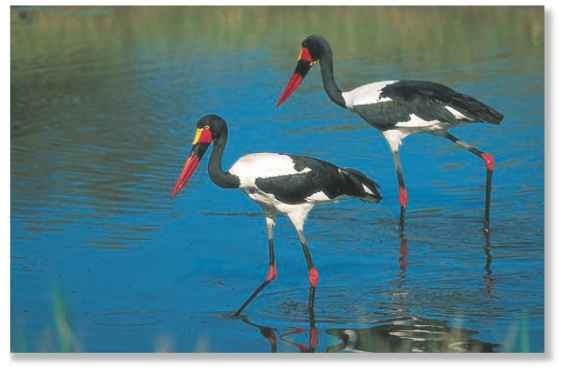ORDER
Ciconiiformes
FAMILY
Ciconiidae
GENUS & SPECIES
KEY FEATURES
• Tallest and most strikingly colored of Africa’s storks; broad wings allow it to soar above the plains
• Wades through marshes and shallow water, snapping up fish and other aquatic prey with its long, sharp bill
• Builds vast nests high in the canopies of tall trees or deep within wetlands, out of the reach of predators
WHERE IN THE WORLD?
Ranges throughout tropical Africa, from southern fringes of the Sahara to northern Namibia, Botswana and northeastern South Africa

Lifecycle
Whether wading through swamps hunting aquatic animals, or soaring above the plains looking for new feeding sites, the saddle-bill stork is one of Africa’s most striking birds.
Habitat
The saddle-bill stork feeds in freshwater areas where there is sufficiently tall woodland nearby in which to roost and nest. Although it is normally wary of humans, storks that live in national parks often become acclimatized to vehicles and lose their natural shyness.
The saddle-bill stork does not make migrations. An established pair remains in its territory throughout the year unless severe drought or very heavy flooding forces them to seek out new feeding grounds.
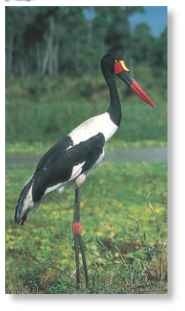
Swamp creature Wetlands offer the stork an abundant food supply.
conservation
Although the stork is widespread, its territorial behavior and the scattered nature of its habitat make it scarce. Though numbers appear to be stable,-regional populations could easily become threatened by habitat loss or capture of young birds for sale to zoos or private collections.
Breeding
A pair of saddle-bill storks mates towards the close of the rainy season. The nest, located up to 100′ high in the crown of a tall tree, may be 6.5′ in diameter: It is constructed from sticks lined with reeds and mud. The stork may occasionally nest deep within a swamp, in a place inaccessible to dry-land predators.
The parent birds take turns incubating the eggs and share the duty of feeding the chicks. Food for hungry chicks becomes easier to find in the dry season because the wetlands shrink, forcing prey into ever decreasing areas. Even after they have fledged, the juveniles continue to demand food from their parents, and they only slowly become independent.
Same again
Pairs renew their bond each year before mating.

Food & hunting
Behavior
A breeding pair of saddle-bill storks forms a bond that may last for life. The pair is territorial, especially during the breeding season, and drives off intruders vigorously Rarely vocal, the stork often clatters its bill during threat displays and other ritual actions. These displays involve the bird’s standing erect with wings outspread while striding aggressively towards the intruder; A pair also performs elaborate courtship displays.
Not an overly sociable bird, the saddle-bill stork usually feeds and roosts in pairs or in small family groups containing the parents and any juvenile offspring. Most foraging takes place in daytime, the stork flying several miles from its roosting spot to feeding grounds.
Stork in a squawk Few are unimpressed by the stork’s threat display.
The saddle-bill stork forages by wading slowly, probing with its huge bill. It often finds its prey by touch, snapping its bill shut on anything that moves.
The adaptable bill serves as a pincer to grasp small animals and as a sharp dagger to impale larger creatures. The stork also uses its long toes to stir up the muddy bottom and flush out prey, briefly pursuing any quarry that escapes an initial bill attack.
Fish are the mainstay of the stork’s diet, and its bill can tackle specimens up to 12″ long. Frogs, snakes, crustaceans, mammals and insects are also on the menu, and this bird may also scavenge for carrion.
marsh marauder
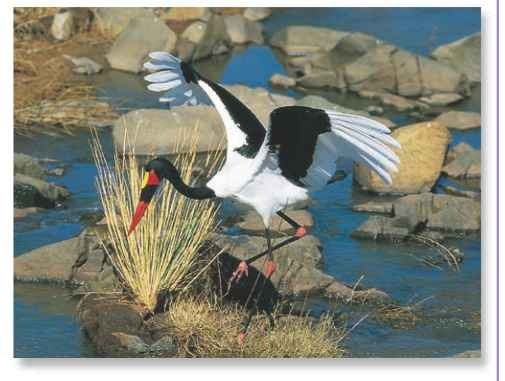

Touch down…
A saddle-bill stork glides in to join other members of the family group at a favorite feeding site on the fringes of a marshy lake.

Close scrutiny…
The stork wades stealthily through the shallows, watching for any movement. It may use its bill to probe underwater.
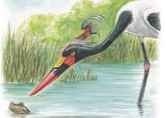
Life at the sharp end…
Staring intently into the water, the bird spies a small frog crouching below and strikes with a sudden lunge of its menacing bill.
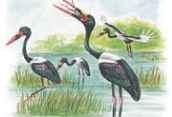
Down the hatch
The prey securely grasped, the stork stands erect, raises its bill and tosses the unlucky frog down into its throat.
The saddle-bill stork snips off the spines and “whiskers” of catfish before swallowing them.
Groups of saddle-bill storks may stay close to a herd of animals, such as hippopotamuses, for protection, while catching creatures disturbed by the large animals’ movements.
An abandoned saddle-bill stork’s massive nest may be used by other large birds such as secretary birds.
PROFILE
Saddle-bill Stork
Long-necked and armed with a daggerlike bill, the saddle-bill stork is an-expert fisher, relying on its bill to locate and catch its prey.
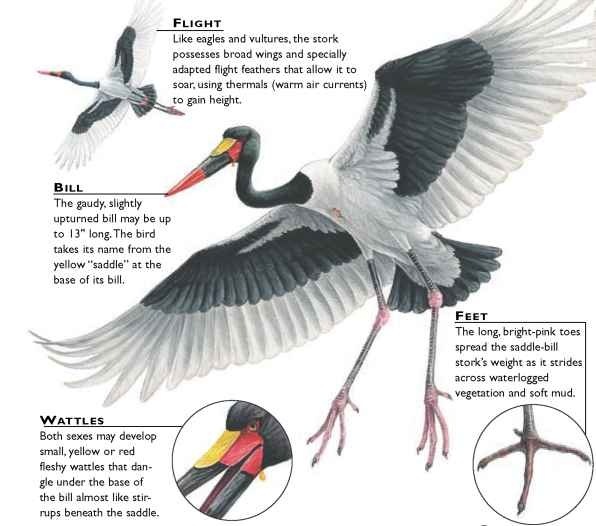
Creature comparisons
The black-necked stork (Ephippiorhynchus asiaticus) is the Indo-Pacific counterpart of the saddle-bill stork, found mainly in India, New Guinea and Australia. The two species are both birds of wetland habitats, with similar food preferences and nesting and breeding patterns. However the Asian bird is slightly smaller than its African cousin, and there are other striking physical differences.The most obvious is bill color the-saddle-bill stork’s spectacular weapon provides a stark contrast to the black-necked stork’s black bill.The black-necked stork has coral-red legs, while the saddle-bill has pink knees and feet.

| VITAL STATISTICS Weight About 13 lbs. |
|
| Length | 4.75-5′; male larger than female |
| Wingspan | 8-9′ |
| Sexual Maturity | 2 years |
| Breeding Season | Rainy season |
| Number of Eggs | 1-5 |
| Incubation Period | 30-35 days |
| Fledging Period | 70-100 days |
| Breeding Interval | 1 year |
| Typical Diet | Fish, frogs, invertebrates and reptiles |
| Lifespan | 36 years in captivity |
RELATED SPECIES
• The saddle-bill stork is 1 of 17 species of stork in the family Ciconiidae. Of the other 5 families that make up the order Ciconiiformes, 2 contain just 1 species each: Balaenicipitidae and Scopidae. The remaining 3 families in the order are the Threskiornithidae containing 31 species; the Ardeidae, containing 60 species; and the Phoenicopteridae, containing 5 species.

